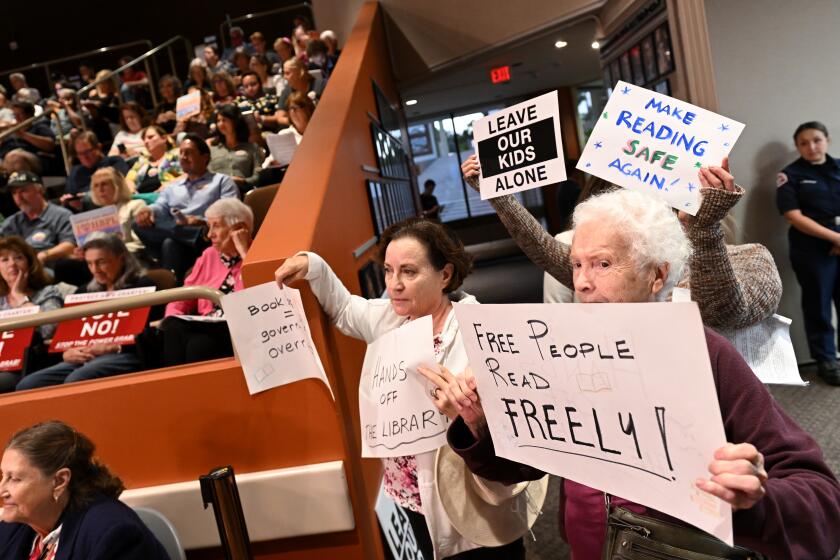Editorial: The science of reading works. California should require it

Strange that it took a lawsuit to show California a better way to teach students to read. And now that a Stanford University study has confirmed the value of the so-called science of reading in a handful of schools, it’s time for the state to get serious about making this the required standard for literacy instruction.
The lawsuit, filed in 2017 by the pro bono law firm Public Counsel, claimed that California schools were failing in their constitutional duty to children by promoting them without the basic reading skills. It pointed to a Los Angeles school where only 10% of the students were at grade level in literacy. And it noted that there was a well-evidenced method of teaching reading that most schools weren’t following. It’s based on building multiple skills, but most notably adding more phonics instruction.
We need legislation to require that every school — or at least all schools with low and stagnant grades — bring the science of reading to its classrooms.
The state settled the suit in 2020, agreeing to provide 75 low-performing elementary schools with about $642,000 over three years, with that money to be devoted to improving to improve reading outcomes. Schools had leeway about how they spent the money, but all turned to the science of reading in literacy instruction, according to Mark Rosenbaum of Public Counsel.
Stanford’s independent examination of that change found considerably improved scores, with significantly higher numbers of third-graders reading at grade level. Science of reading also is the literacy curriculum used by the Los Angeles Unified School District’s Primary Promise program, which has shown measurable improvements in reading proficiency. Sadly, the program is being cut back.
Mathematics scores improved a little, too, in the schools using science of reading. That shouldn’t be a big surprise: Most subjects are taught at least partly through reading.
Giving residents censorship rights over librarians and the public crosses a clear line that should never be breached.
It’s an impressive-sounding moniker, the science of reading. But many successful teachers call it common sense and have been using it informally for years. It involves more direct instruction by the teacher, a significant dose of phonics, or sounding out words from letters, as well as building vocabulary, encouraging students to read aloud and helping them comprehend what they’re reading.
In contrast, the two other principal methods of literacy education followed the theory that reading comes naturally to children, who just need to be exposed to engaging literature and figure out words by guessing them from the pictures and other context. While this actually does work for 30% of students, it leaves the futures of the other 70% in peril.
Opponents of science of reading complain that phonics is too mechanical. But it doesn’t have to be if combined with vocabulary and enjoyable literature. Besides, what’s worse, a couple of years of sounding out words to build fluency and comprehension, or a lifetime of illiteracy?
Consider La Salle Avenue Elementary in Los Angeles. Its most recent scores show only a quarter of students reading at or above grade level. That’s awful, far lower than the 46.7% of LAUSD students who read proficiently, which also isn’t an acceptable number. But in 2017, when the lawsuit was filed, only 10% of La Salle third-grade students read at grade level. And this improvement after several years of using science of reading has occurred despite the pandemic and remote learning, which has hurt reading scores across the nation.
Of course, it’s not enough just to change the curriculum, the Stanford researchers concluded. Teachers need training; hiring reading coaches helps, too. Some schools used part of their funding from the settlement to engage parents in their children’s reading. These changes also appear to have helped.
Aside from promoting and protecting students’ physical and mental well-being, there is nothing more important than to help them learn to read. Perhaps the Local Control Funding Formula, which hands a tremendous amount of spending authority to school districts, should be rejiggered to put more of the money meant to help struggling students toward reading.
State Superintendent of Public Instruction Tony Thurmond says the evidence supports science of reading, and he favors training teachers in it. But he is skittish about requiring schools to adopt it.
That’s too bad. Schools need a sense of urgency to ensure that California students are improving academically right now, especially those in marginalized groups and from low-income families.
More to Read
A cure for the common opinion
Get thought-provoking perspectives with our weekly newsletter.
You may occasionally receive promotional content from the Los Angeles Times.







